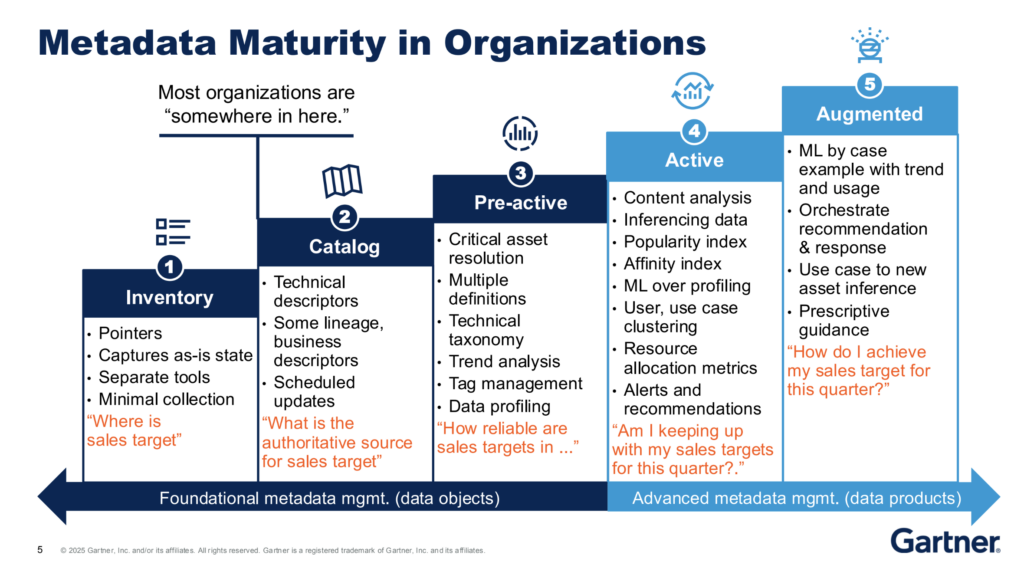
Active Metadata: Your Secret Weapon for Data-Driven Success
Insights from Mark Beyer’s talk: “Managing Metadata: From Passive to Active Metadata”, Gartner D&A Summit 2025
Remember when metadata was just that boring “data about data” collecting dust in your systems? Oh, I know what you’re thinking: “Here’s another tech article telling me something I already have is suddenly important.” But stick with me. Because this one’s different. This is about the secret asset you already own but haven’t cashed in on yet.
Metadata has stepped into the spotlight, transforming from the shy understudy to the star of the show in our AI-powered world. I recently caught Mark Beyer‘s eye-opening Gartner presentation on “Managing Metadata: From Passive to Active Metadata,” and let me tell you, what’s happening with metadata right now isn’t far from another tech fad. It’s changing the game.
This is about turning your entire data approach on its head (in a way that will actually make your life easier). So, if you’re still treating metadata as an afterthought but have a nagging sensation that you’re missing something important… Trust that instinct: it’s trying to save your business.
The Problem Isn’t What You Think
Traditional metadata was passive, static information about data, stored separately, rarely updated, and even less frequently utilized (your classic “data about data”). It was often treated like paperwork: essential yet hardly inspiring. But with the rise of analytics and AI, passive metadata faces a critical challenge.
For years, we’ve been operating under a false assumption: metadata was just “too big” to fully manage. We cherry-picked what seemed “important” or “meaningful” and ignored the rest. It was kind of like trying to understand a novel by reading only chapter titles.
Analytics has made metadata even bigger and messier. Beyer described analytics metadata as “ginormous”- chains of inference and calculations creating vast webs of relationships. Let’s put this into perspective:
- Every analytic operation generates metadata, consisting of chains of inference and calculations.
- Machine learning further extends metadata complexity through clustering, user profiling, trend analysis, and popularity indexing.
- Metadata that started as mere descriptions of data now form intricate networks, referred to as metadata graphs.
Add AI to the mix, and you’ve got a “wide and deep” active graph that makes most traditional approaches buckle under pressure.
But contrary to what you may think, this complexity isn’t the problem. It’s the opportunity knocking on your door. Mark Beyer called this out with a truth bomb: “Stop complaining you don’t have enough metadata — you have enough, you just don’t use it.” It’s not about having more. It’s about doing more (with what you already have).

Where Are You on the Metadata Maturity Journey?
Most of us are stumbling somewhere in the middle of the metadata maturity path. According to Beyer, there are five stages, and knowing where you stand is the first step to leveling up:
- Inventory (The Basics): You’ve got pointers and minimal collection info. Your systems can answer “Where is the sales target?” but not much else. It’s like having a map that just says, “treasure somewhere in this country.”
- Catalog (Getting Better): You’ve added technical descriptors, some lineage tracking, and regular updates. Now you can answer “What is the authoritative source for sales targets?” You’ve zoomed in on the map a bit.
- Pre-active (The Middle Ground): Here, you’re working with multiple definitions, technical taxonomy, and data profiling. You can now answer “How reliable are sales targets in…?” You’re getting warmer.
- Active (Now We’re Talking): This is where the magic happens – content analysis, ML over profiling, user clustering, alerts, and recommendations. Your business can answer “Am I keeping up with my sales targets for this quarter?” This is like having a treasure map with turn-by-turn directions.
- Augmented (The Promised Land): You’ve got ML working with trends and usage patterns, orchestrated recommendations, and prescriptive guidance. Your systems can now tell you, “How do I achieve my sales target for this quarter?” The treasure is practically digging itself up!
So far, only 12% of companies have implemented active metadata analysis.
This means that most organizations linger somewhere around steps 2 and 3. You’re likely part of that majority, facing similar challenges as everyone else but also looking at the same massive, untapped opportunity.
What’s more, AI readiness (making sure AI models receive accurate, relevant, and context-rich data) is highly dependent on this metadata-driven approach.
Trust in data doesn’t come from fancy certifications. It comes from seeing patterns.
By watching how data flows and how people in your organization actually use it, you build real, quantifiable trust.
Your systems are already showing you what works.
The question is: Are you paying attention?
Three Ways Active Metadata Makes Your Business Smarter
AI demands more than passive inventory-style metadata. It needs metadata that’s live, responsive, and continuously enriched by interaction. Active metadata turns static documentation into dynamic insights. It captures traditional descriptive information and logs real-time user interactions, data usage patterns, performance metrics, and inference trails.
This shift is quickly becoming table-stakes territory for businesses that want to stay relevant. Here’s why.
1. Trust Comes From Watching, Not Talking
Trust in data doesn’t come from fancy certifications. It comes from seeing patterns. By watching how data flows and how people in your organization actually use it, you build real, quantifiable trust.
In application integration, you transform data between contexts. In analytics, you qualify data for specific uses. For AI readiness, you connect all metadata regardless of source.
As Beyer put it: “Business shows what it likes with 10,000s of run-time observations from warehouses, data marts, data products, pipelines & microservices.”
Your systems are already showing you what works. The question is: Are you paying attention?
2. See Everything, Miss Nothing
To build real trust, you need to watch your data from all angles:
- Quality Tracking: Profile your data coming in and going out to catch “drift” before it becomes a problem
- Usage Patterns: See how people actually use your data in real life, not how you imagine they do
- Performance Checks: Spot infrastructure bottlenecks before they slow you down
Together, these practices help you, as Mark Beyers eloquently puts it, “build data trust by closely monitoring data sets for changes in size, quality ‘drift’, access rights and then compare that to use cases to see who is using what, how often and if usage changes.”
Interestingly, 64% of organizations use metadata governance solutions, but fewer employ truly active, AI-enabled governance. This highlights another opportunity gap.
3. Making AI-Ready Data a Reality
AI isn’t merely hungry for data. It craves contextualized, semantically rich data. Active metadata feeds AI models precisely this kind of nourishment.
By activating metadata, organizations can create extensive graphs linking business context, interpretation, sentiment, and usage directly to the data. This produces AI-ready datasets capable of quick deployment without extensive model retraining or manual labeling.
One of Beyer’s most interesting points is that the wall between structured and unstructured data is entirely artificial. Why treat your spreadsheets and your documents like they’re from different planets? Active metadata techniques can bring these worlds together.
“AI-ready data combines variable structures using metadata chaining,” Beyer emphasized. Your AI initiatives need this unification like a car needs both wheels and an engine. They’re both essential parts of the same machine.
The Secret Ingredient in Your AI Recipe
Every time data gets reused, especially by AI systems, it creates new metadata. And AI will reuse your data at speeds that make humans look like they’re moving in slow motion and create torrents of new metadata in the process.
As Mark Beyer notes, “AI will reuse data faster than humans,” emphasizing how automated, metadata-driven responses mirror human decision-making. This means it’s vital to make sure metadata aligns with actual business usage.
Beyer presented an interesting point of view. Businesses already surround their numbers with rich context:
- Who sees this report (distribution lists)
- Why this report exists (business descriptions)
- What it means (interpretations and sentiment)
All of this is valuable metadata gold. “Since the business already surrounded their numbers with metadata, why are you asking them again?” Beyer challenged. Stop reinventing the wheel. Start using the wheels you already have.
“Metadata is data observability. Semantics comes directly from business observability.
Active metadata puts them together.”
— Mark A. Beyer, Distinguished VP Analyst, Gartner
Turn the Tables Through Data Management Inversion
Mark Beyer’s “inversion model” completely breaks the mold of traditional data management:
- Stop designing data: Quit trying to force your data into perfect little boxes
- Start watching metadata and analyzing patterns: Let actual usage be your guide
- Build alerts for when things change: Be ready when data behaviors shift
As Beyer simply stated, “Data management inversion is possible because of active metadata.” This means not only changing how you do things but changing how you think about data management altogether.
So what should you do if you want to join the active metadata revolution? Beyer gave a simple roadmap:
- Collect diverse metadata and analyze it like any other data: Your metadata deserves the spotlight
- Use Active Metadata to break down the structured vs. unstructured divide: Stop treating different data types like strangers at a party
- Build trust by watching what matters: Continuous observation creates confidence
How illumex Turns Your Metadata Dreams Into Reality
illumex’s Generative Semantic Fabric (GSF) platform turns the theoretical benefits Beyer outlined into practical, everyday reality for your business. It doesn’t simply manage your metadata; it activates it, and makes it work for YOU.
The platform automatically discovers, labels, and maps your structured (meta)data without moving it from its original locations. No more data migrations. No more endless manual tagging sessions.
illumex connects to your metadata; it actively analyzes and connects it into a unified, single source of truth for your structured data. It adds definitions, lineage, business context, and usage context. Think of it as having a team of data scientists working 24/7 on your metadata but without the coffee breaks and vacation requests.
As illumex maps and semantically reconciles your structured data, it automatically flags duplications, errors, and sensitive information like PII. It creates a Business Glossary with auto-generated business terms and suggested definitions. And the beauty of it is that this, too, happens automatically.
Your governance and data management processes that used to take weeks and months now happen in real time – moving as fast as AI does. Plus, when anything in your (meta)data changes, you’ll get instant alerts, making sure you’re always up to date.

Active Metadata for Reliable Agentic AI and Governed Self-Serve Analytics
illumex has your back no matter where you are on your AI journey. Once you implement agentic and generative AI, illumex guarantees you and your business users will always get accurate, deterministic answers drawn from your organizational semantic knowledge graph. It’s like having a fact-checker built into every AI interaction.
With illumex, analytics agents can interpret user questions (and their intent) with precision, delivering responses you can actually trust.
The platform continuously derives context from your metadata. This shows not only the user intearactions with the analytics agent or data copilot, but also the different interactions with other system connected to illumex.
illumex fulfills Beyer’s vision of the ideal future state, and it achieves it today.
It automatically activates your metadata, turning it from passive documentation into an active business ally. It helps your organization make better, smarter, data-based business decisions without requiring you to hire an army of specialists or spend years rebuilding your data architecture.
With illumex, you can:
- Get your data AI-ready in days, not months
- Achieve 90% faster governance processes
- Cut 80% of token costs when deploying enterprise Agentic and GenAI models
- Make 100% of your decisions with data
Most importantly, illumex makes it possible for every employee in your company (not just the tech folks) to make data-based decisions 100% of the time without special technical skills.
Remember Beyer’s point about how businesses already surround their numbers with rich contextual metadata? illumex captures all of that value that’s currently going to waste and puts it to work.
The Final Word: Act Now or Get Left Behind
The shift from passive to active metadata management isn’t a fad or another tech trend. It’s a business revolution happening right under your nose. Most organizations are still fumbling in the early stages while the leaders are accelerating away.
By embracing active metadata principles – observing patterns, breaking down artificial divisions, and building trust through monitoring – you’ll transform how your organization makes decisions.
Remember Beyer’s words: “Metadata is data observability. Semantics comes directly from business observability. Active metadata puts them together.”
With illumex, you can turn this vision into your new reality.
The metadata revolution doesn’t wait for permission. Your competitors are already moving. The question isn’t whether you should join this revolution; it’s whether you can afford not to.
Discover how illumex can support your Agentic AI transformation




